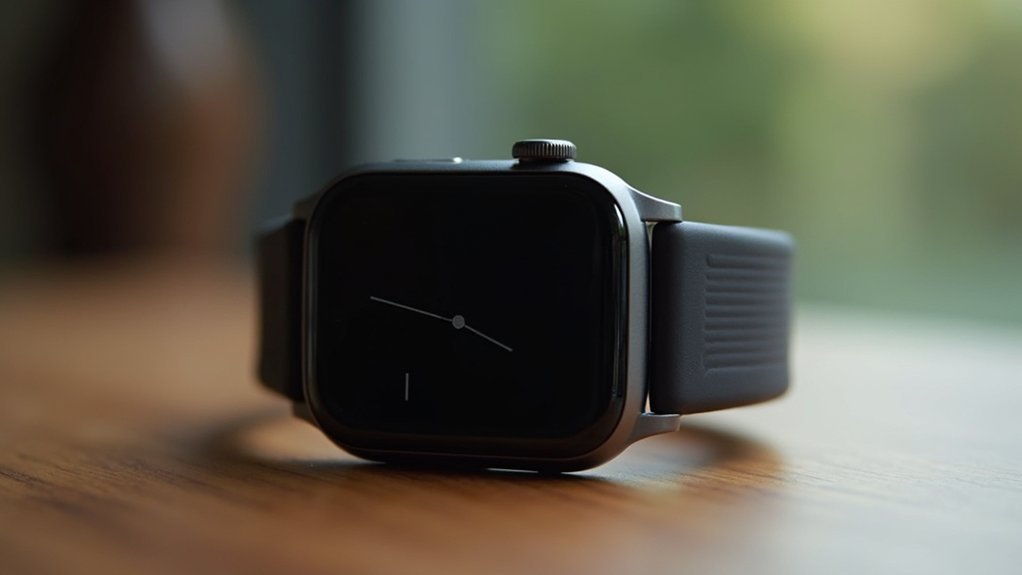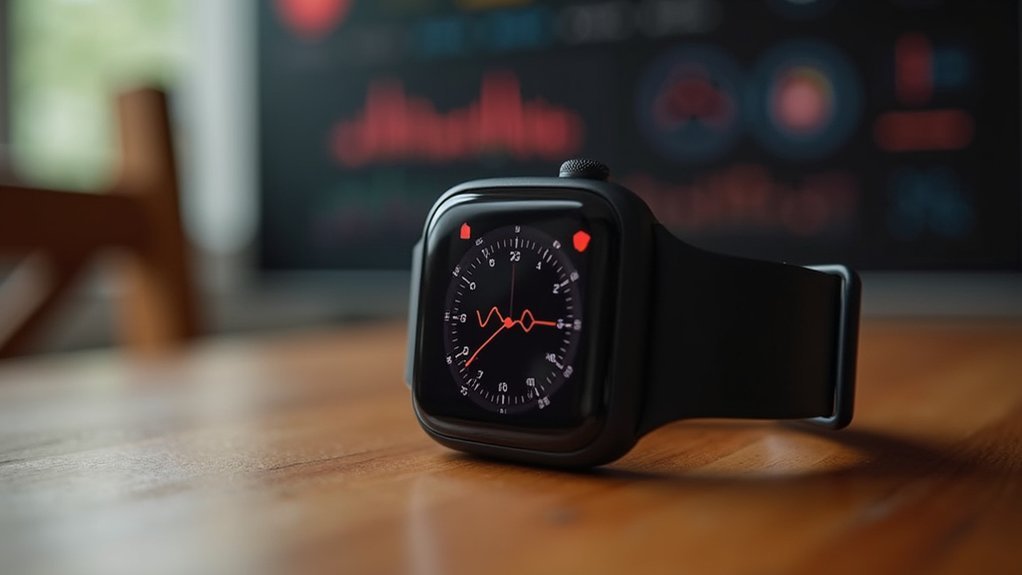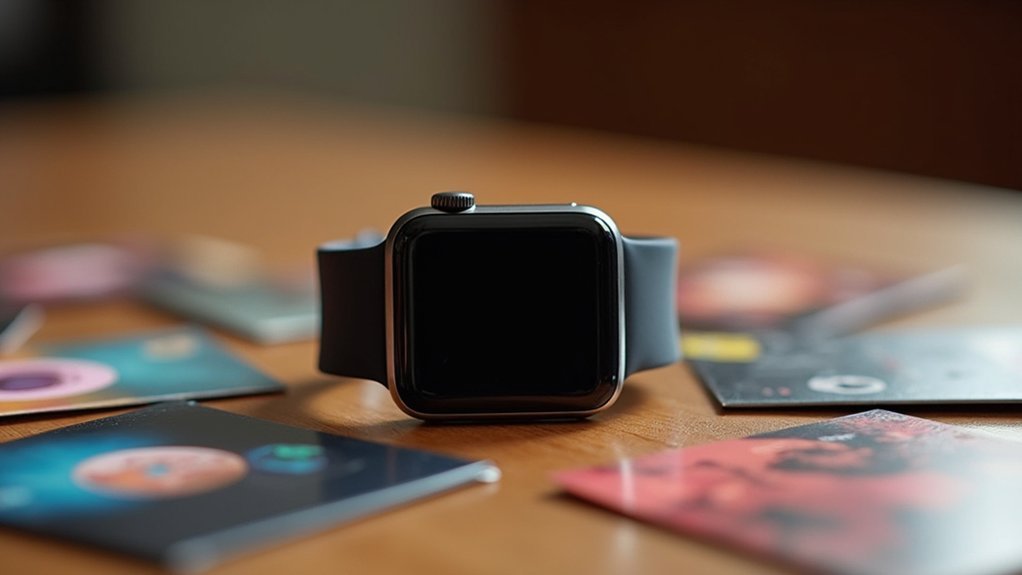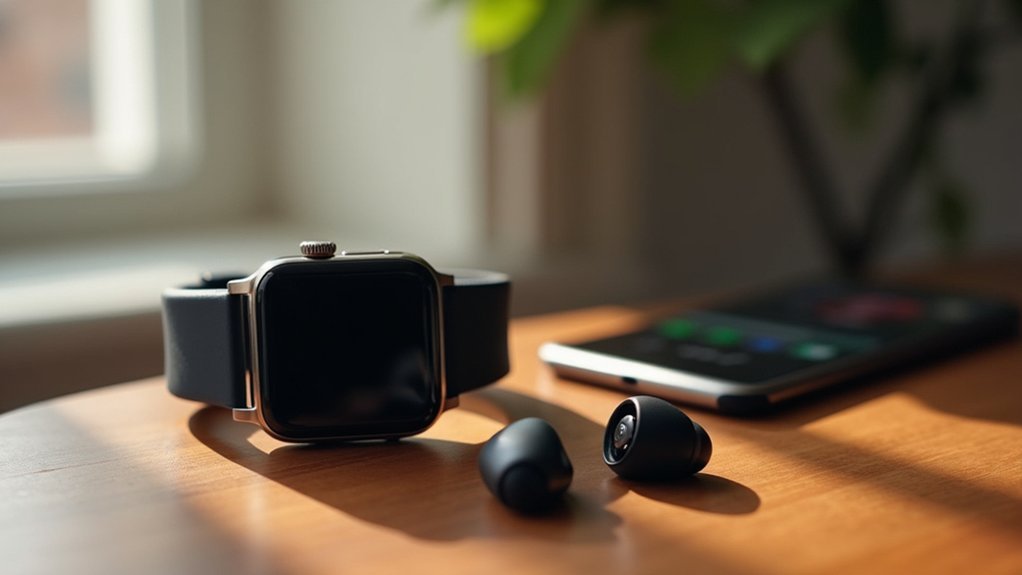Smartwatches vary in heart monitoring quality based on sensor technology and configuration. Premium devices use multiple LEDs (green or red wavelengths) with sophisticated algorithms to filter motion artifacts. Factors like proper fit, sensor placement, and processing capability greatly impact accuracy. Medical-grade features in high-end models even offer FDA-approved ECG and arrhythmia detection capabilities. For serious health tracking or athletic training, these differences in technology and design become vital to reliable performance.
Optical vs. Electrical Heart Rate Sensors: The Technology Difference

While most people recognize smartwatches primarily as time-telling devices, their ability to monitor heart rate relies on two fundamentally different technologies.
Optical sensors, common in smartwatches, use light to detect blood volume changes in your capillaries. They’re convenient but less accurate during intense activity.
Electrical sensors, typically found in chest straps, directly capture your heart’s electrical signals. This method provides superior accuracy, especially during exercise, and can detect rhythm irregularities. ECG-equipped smartwatches offer the advantage of creating detailed cardiograms that provide comprehensive information about your heart’s condition.
The core difference lies in what they measure: optical sensors track blood flow indirectly through light reflection, while electrical sensors measure your heart’s actual electrical activity.
This distinction explains why serious athletes often prefer chest straps despite the comfort advantage of wrist-worn devices.
Sensor Quality and Configuration Impact on Accuracy
Your smartwatch’s heart rate accuracy depends greatly on its LED configuration, with multiple sensors providing more reliable readings across different skin tones and conditions.
Green wavelength LEDs, found in most consumer devices, work well for everyday monitoring but struggle during intense exercise due to their limited penetration depth.
Red wavelength sensors, while less common, offer superior accuracy during high-intensity activities and can better detect blood oxygen levels, which explains their increasing inclusion in premium smartwatch models.
Our tests revealed that devices with advanced sensor technology showed significantly better performance during varied activities, with correlation coefficients reaching near 1.0 for running and cycling sessions.
Multiple LED Placement
The configuration and quality of LED arrays in smartwatch heart rate monitors directly influence measurement accuracy across diverse situations. When you’re shopping for a smartwatch, the number and arrangement of LEDs matters greatly.
Watches with multiple LEDs can sample across a broader skin area, maintaining accuracy during movement and compensating for poor contact. This is especially essential for darker skin tones where signal challenges increase. The most effective sensors incorporate active signal characterization to filter out optical noise that commonly affects wrist-based monitoring.
| LED Configuration | Benefits | Best For |
|---|---|---|
| Single LED | Basic tracking | Resting measurements |
| Dual LED array | Better motion tolerance | Casual exercise |
| Tri-LED cluster | Improved skin tone adaptation | Regular fitness users |
| Quad+ LED matrix | Maximum redundancy | Athletes, diverse users |
| Angled LED placement | Optimizes wrist contact | All-day monitoring |
The placement of these LEDs—particularly toward the center of your wrist—enhances signal penetration and quality, keeping readings reliable even during intense activities.
Green vs. Red Wavelengths
Beyond LED placement, the specific light wavelengths used in smartwatch sensors fundamentally affect measurement accuracy. Most modern devices utilize green light (520-530 nm) rather than red (645 nm) for heart rate monitoring via PPG technology.
Green light offers superior accuracy, with measurements differing only ±0.61 bpm from clinical ECG readings, compared to red light’s ±3.20 bpm variance. You’ll get more reliable readings during exercise too, as green wavelengths maintain better signal quality during movement with fewer motion artifacts. PPG sensors in smartwatches continue to face challenges from motion artifacts and ambient light interference that can compromise accuracy.
While red and infrared light penetrate deeper into tissue, they’re more susceptible to motion interference and skin tone variations. This explains why your Apple Watch and other premium wearables primarily use green LEDs—they provide consistent performance across different skin tones while maintaining accuracy during physical activity.
How Device Design Affects Heart Rate Precision

While smartwatches have revolutionized personal health tracking, their ability to accurately monitor heart rate depends considerably on thoughtful design elements. Proper sensor positioning and quality drastically reduce error margins, with multiple LED types enabling deeper skin penetration for better readings.
You’ll get more accurate results from devices that incorporate motion artifact management—a critical feature that filters out movement-related noise through accelerometers and sophisticated algorithms. Upper arm devices like Polar typically show lower error rates compared to wrist-worn options during exercise.
The watch’s fit matters too; a snug, comfortable design guarantees consistent skin contact without slipping during activity.
Signal processing capabilities separate premium devices from basic ones. Real-time filtering, frequency isolation, and dynamic sampling rates all contribute to precision.
That’s why some brands outperform others, especially during high-intensity workouts or sleep when subtle heart rate changes need detection.
The Role of Algorithms in Heart Rate Monitoring
Behind every accurate heart rate reading on your smartwatch lies sophisticated algorithmic processing that transforms raw sensor data into meaningful health insights.
These algorithms analyze your pulse signals in 30-second to 1-minute segments, carefully filtering out motion noise during periods of inactivity. However, some devices like KardiaBand demonstrate higher accuracy rates than others when detecting heart rhythm abnormalities.
The best algorithms can detect atrial fibrillation with impressive accuracy—some achieving 98.1% sensitivity and specificity.
Your device’s effectiveness depends on:
- Advanced parameters like sample entropy (SampEn) and root-mean-square of successive differences (RMSSD)
- Real-time, continuous monitoring to catch intermittent rhythm irregularities
- Smart notification systems that alert you to potential issues
- Overlapping analysis of pulse information to enhance detection sensitivity
When abnormal patterns emerge, your smartwatch can prompt you to seek medical evaluation, potentially catching serious conditions before symptoms appear.
Performance Variations During Different Activities

As you push your body through different types of physical activity, your smartwatch’s heart rate monitor responds with varying levels of accuracy.
Most devices perform admirably during moderate, steady-state activities like jogging or cycling, typically staying within 5-10 bpm of your actual heart rate.
However, your watch struggles during high-intensity workouts with rapid movements. Activities like HIIT, tennis, or weightlifting create motion artifacts that can throw off readings considerably.
Water-based activities pose additional challenges due to changing skin conductivity.
Device placement matters too—a loose fit causes inaccurate readings as the watch shifts against your skin. Mountain biking tests reveal that proper wrist positioning can significantly improve smartwatch accuracy compared to road cycling.
While Apple Watch and Fitbit devices achieve 100% accuracy within 10 bpm during controlled tests, no single device excels across all activity types.
For serious training, look for devices with 5% or better accuracy.
Medical-Grade Features in Modern Smartwatches
Modern smartwatches now include FDA-approved heart monitoring features that can detect atrial fibrillation with clinical-grade accuracy.
You’ll find multi-lead ECG capabilities on premium models like the Apple Watch Series 4+ and Samsung Galaxy Watch, allowing you to record and share single-lead electrocardiograms directly with your healthcare provider.
These devices offer potentially life-saving arrhythmia alert systems that notify you of irregular heartbeats, empowering early detection of cardiac conditions before they lead to serious complications.
Some smartwatches even provide features like the Apple Watch AFib History that delivers weekly notifications with estimates of time spent in atrial fibrillation.
FDA-Approved Heart Detection
While consumer smartwatches continue to evolve, FDA-approved heart monitoring features represent a significant leap forward in wearable health technology.
These cleared devices offer medical-grade reliability that you can trust for both clinical and self-monitoring purposes.
FDA clearance isn’t easily obtained—it requires rigorous validation of sensor accuracy and consistent performance.
When you choose a smartwatch with these approved features, you’re getting technology that’s been specifically tested for:
- ECG capabilities that provide single-lead electrocardiograms
- Irregular rhythm notifications that detect potential arrhythmias
- Continuous heart rate monitoring with clinical-grade accuracy
- Blood oxygen saturation measurements for respiratory health
This level of certification means you can confidently share the data with your healthcare provider, potentially reducing unnecessary hospital visits while maintaining proactive heart health management. The Apple Watch specifically has demonstrated its ability to detect potential issues early, enabling timely intervention and preventive care.
Multi-Lead ECG Capability
Recent technological advances have transformed smartwatches from basic heart rate monitors into sophisticated medical devices capable of recording multi-lead ECGs.
While most current smartwatches offer only single-lead ECG (typically lead I), experimental methods now allow recording of leads II and III through different body placements.
These multi-lead capabilities greatly enhance diagnostic accuracy, making smartwatch readings more comparable to clinical 12-lead ECGs. Initial studies revealed a low sensitivity of just 34% for detecting ST-segment abnormalities using single-lead smartwatch ECGs, highlighting the need for multiple leads. You’ll benefit from improved detection of conditions like myocardial infarction, though clinical ECGs remain necessary for thorough diagnosis.
The advantage is clear: multiple leads provide more detailed cardiac information, reduce errors, and enable continuous monitoring that may catch problems earlier than traditional methods.
As sensor technology and data analysis improve, you can expect future smartwatches to offer even more sophisticated ECG capabilities that bridge the gap between convenience and clinical reliability.
Arrhythmia Alert Systems
Beyond multi-lead ECG capabilities, smartwatches now feature sophisticated arrhythmia alert systems that transform them into medical-grade monitoring devices.
These systems continuously monitor your heart rate through PPG sensors and single-lead ECGs, analyzing the data with advanced algorithms to detect irregular rhythms.
When your watch detects an arrhythmia, you’ll receive an immediate alert, prompting you to seek medical evaluation if necessary.
These alerts have been clinically validated for:
- Atrial fibrillation (AFib) detection with high sensitivity and specificity
- Tachycardia and bradycardia identification even when you’re asymptomatic
- Real-time feedback processed directly on your device
- Broader arrhythmia detection including premature beats
Despite single-electrode limitations, these systems provide valuable screening that was previously available only in clinical settings, making early arrhythmia detection accessible to everyone. Multiple studies have shown smartwatches demonstrate noninferiority compared to traditional medical-grade monitoring devices for detecting cardiac irregularities.
Frequently Asked Questions
How Do Skin Tone and Tattoos Affect Heart Rate Monitoring Accuracy?
Darker skin tones and tattoos reduce heart rate monitoring accuracy by absorbing light from PPG sensors. You’ll experience less precise readings as melanin or ink interferes with the sensor’s ability to detect blood flow changes.
Can Smartwatches Detect Heart Attacks or Other Cardiac Emergencies?
Yes, smartwatches can detect signs of heart attacks with 93-95% accuracy using ECG technology. They’ll alert you to abnormalities but aren’t designed to diagnose. They’re excellent at identifying arrhythmias with 100% sensitivity.
How Often Should I Calibrate My Smartwatch Heart Monitor?
You should calibrate your smartwatch heart monitor every 1-3 months and after significant changes in fitness, weight, or device updates. More frequent calibration is beneficial if you do HIIT or have heart conditions.
Do Heart Medications Interfere With Smartwatch Heart Rate Readings?
Yes, heart medications like beta-blockers can interfere with your smartwatch readings by altering your heart rate. They may reduce accuracy or trigger false alerts when your medication-lowered heart rate doesn’t match expected patterns.
What’s the Battery Life Impact of Continuous Heart Monitoring?
Continuous heart monitoring drains your battery considerably, reducing life by 30-50%. You’ll notice 3-14 days of usage depending on your watch model, with solar options and power-saving modes helping extend runtime.
In Summary
You’ll find significant differences in heart monitoring quality across smartwatches based on sensor technology, placement quality, and algorithm sophistication. The best monitors combine multiple sensors, advanced processing, and ergonomic designs that maintain contact during movement. When selecting a device, consider whether you need basic fitness tracking or more extensive health monitoring that approaches medical-grade accuracy for conditions like AFib or irregular heartbeats.





Leave a Reply